1stepdownload.com (Removal Guide) - Free Instructions
1stepdownload.com Removal Guide
What is 1stepdownload.com?
1stepdownload.com is a deceptive website that delivers intrusive pop-ups
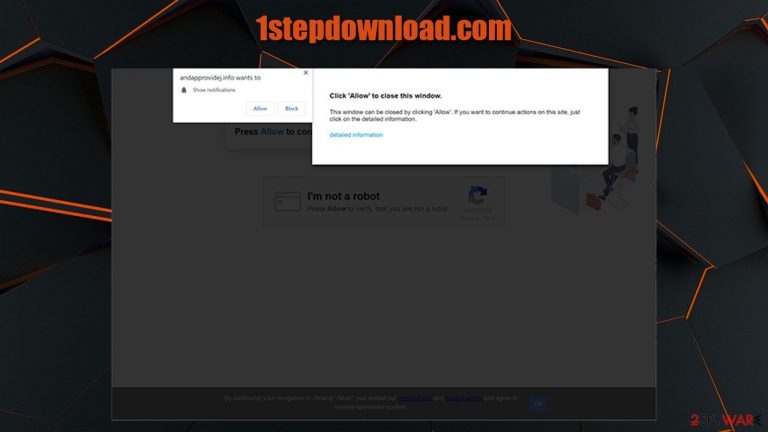
1stepdownload.com is an URL that could appear on your browser after you get redirected from somewhere else. Upon entry, you would see a prompt that would ask you to enable notifications to be received from the site. If you agree to do that, intrusive pop-ups will start showing up on your desktop in regular time intervals, whether you like it or not.
If you are not familiar with this scam, we will explain to you how it works in subsequent paragraphs. Also, the reason you are here is probably that you want to get rid of these pesky, annoying ads. Do not worry; you can find 1stepdownload.com removal instructions below this article.
| Name | 1stepdownload.com |
|---|---|
| Type | Push notifications, pop-ups |
| IP address | 172.67.150.177 |
| Distribution | The unwanted ad activity starts as soon as “Allow” button is pressed in the notification prompt |
| Symptoms | Regardless of which browser is used, notifications from the site will be shown directly on users' desktops |
| Dangers | Installation of potentially unwanted programs or malware, data loss, information leak, financial losses due to encountered scams |
| Deletion | You can stop the intrusive notifications by accessing web browser settings, as explained in the instructions below. If you suspect adware infection, you should use security software to eliminate it quickly |
| Further steps | Cleaning web browsers is just as important when dealing with potentially unwanted programs, so do so by following the instructions below or use FortectIntego as an automatic fix |
First of all, let's talk about how you got to this shady website in the first place. As already mentioned, you could have been redirected from another shady website (for example, pirated software distribution platforms) or after you clicked on an ad accidentally. This behavior is not uncommon online, so you should be very careful with it in the first place – especially if you end up on high-risk websites.
Alternatively, adware[1] installed on your system could be the reason why your Google Chrome, Mozilla Firefox, MS Edge, or another browser is taking you to weird places such as 1stepdownload.com. If that happens to you, you should ignore all the content displayed on the page, leave it immediately and check your system for adware. You can use SpyHunter 5Combo Cleaner or another reputable security software for that.
Once you access the website, you might be presented with the following message:
Click “Allow” if you are not a robot
Alternatively, you might see a download prompt or that you should click Allow in order for a video from YouTube to be played. In reality, there is no content to be shown after the button is clicked. Instead, you will be redirected to another shady website that could ask you to do the same thing, just use a different technique to trick you into doing so.
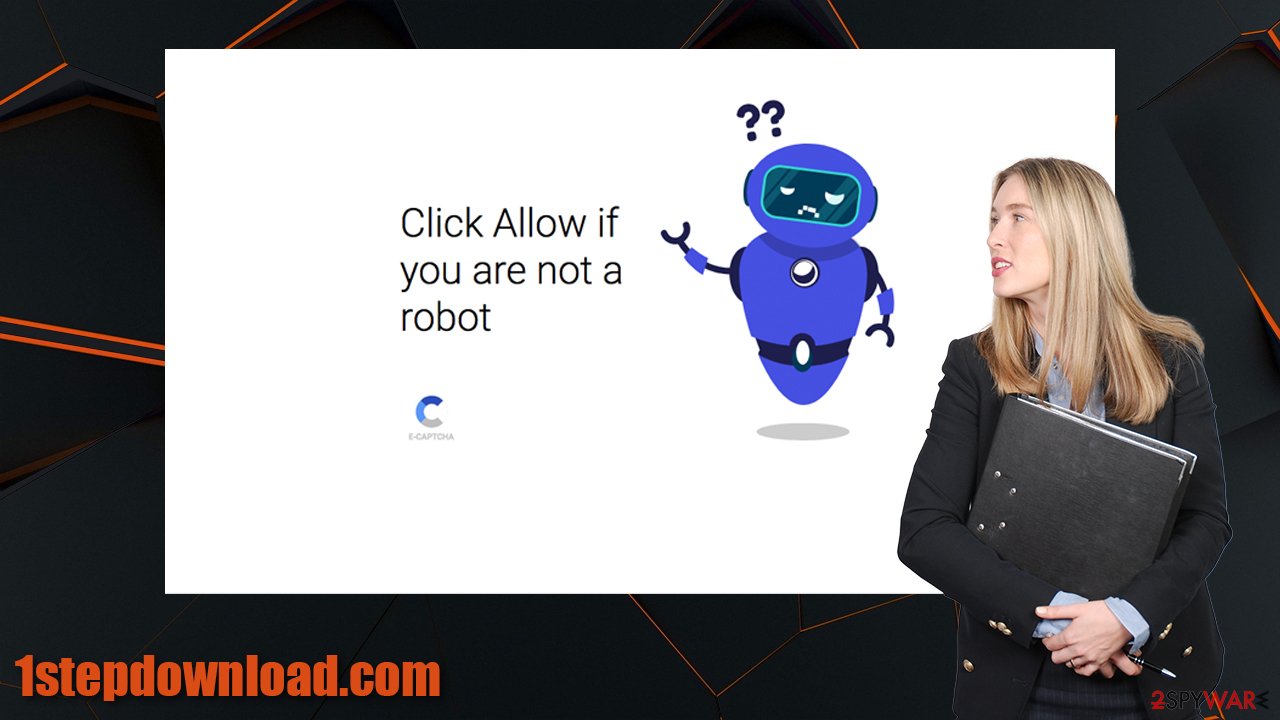
In general, push notification scams are extremely common – Newsdom.cc, Connect.wcsoft.link and Sixmedia.cam are perfect examples. Cybercriminals create these websites in order to fool innocent people and then profit from ad revenue – the ads that are shown directly on users' desktops.
Speaking of which, if you click on these pop-ups, you could be taken to malware-laden or scam website, where your personal details could be stolen, or a Trojan could be installed on your system automatically (cybercriminals use software vulnerabilities to penetrate your system without you having to even click on anything – so make sure all your software is patched with the most recent updates).
As long as you don't click on 1stepdownload.com ads and links, you should be relatively safe. All you have to do is remove the annoying pop-up notifications, we provide instructions for every browser below. You should also clean your browsers from the accumulated web data and cookies – you can do that automatically with FortectIntego.
Online scams are common: here's how to avoid them
Push notification scams are very common and, while these pages are getting shut down by service providers relatively quickly, some manage to stay online for a while. Besides, crooks create new ones on a regular basis and, since each of these sites is basically a copy of one another, it takes them very little time to do so.
Therefore, even if the internet is a much safer place than it used to be 20 years ago, you should always use caution, as scammers are there for that juicy ad revenue, your money, or data. Here are a few tips from security researchers at virusi.hr:[2]
- Don't trust notifications that claim your system is infected with a virus or that something is missing (for example, Flash Player is often used for this, even though this software is no longer available or needed);[3]
- Equip your system with modern anti-malware and web protection apps;
- Do not visit pirated software distribution websites;
- Always check the URL of the website that you are visiting – the page might look like a warning from Microsoft, but it is actually a scam;
- Never open suspicious email attachments from unknown sources, especially those that ask you to enable macros.
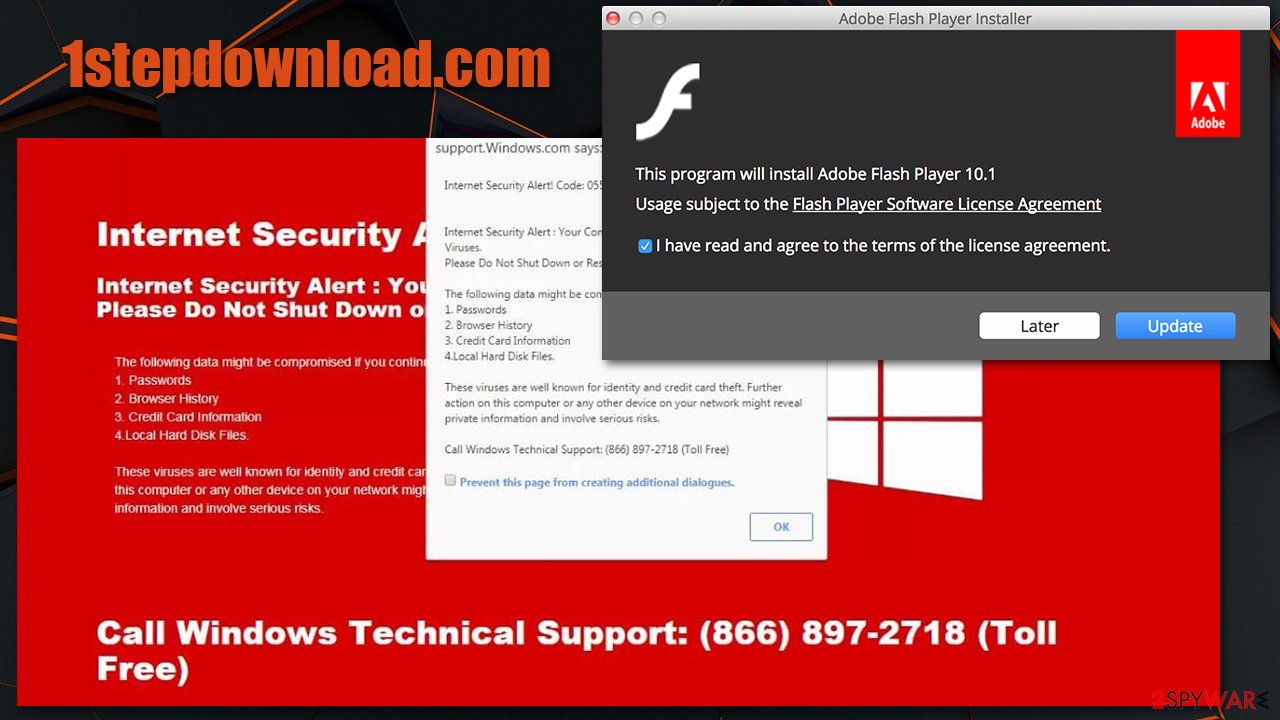
Delete 1stepdownload.com notifications from your browser
It is important to note that regardless of which browser was used to enable notifications for a particular site, they will appear on your desktop. However, in order to remove 1stepdownload.com ads, you would have to access the settings of the browser you allowed this to happen in the first place.
Thus, if you are using Google Chrome, use the instructions below on how to stop a website from sending you notifications. Keep in mind that the same guide can be used to disable notifications from any website on the internet.
However, if the strange browser behavior does not stop (for example, you still receive random redirects to suspicious sites or pop-ups show up on most sites that you visit), you should check your device for adware. The best way to do that is by scanning the machine with SpyHunter 5Combo Cleaner and then using FortectIntego to clean web browsers accordingly. Alternatively, you can use the guide below and do it manually.
Getting rid of 1stepdownload.com. Follow these steps
Stop browser notifications
Remove unwanted notifications from Google Chrome (desktop):
- Open Google Chrome browser and go to Menu > Settings.
- Scroll down and click on Advanced.
- Locate Privacy and security section and pick Site Settings > Notifications.
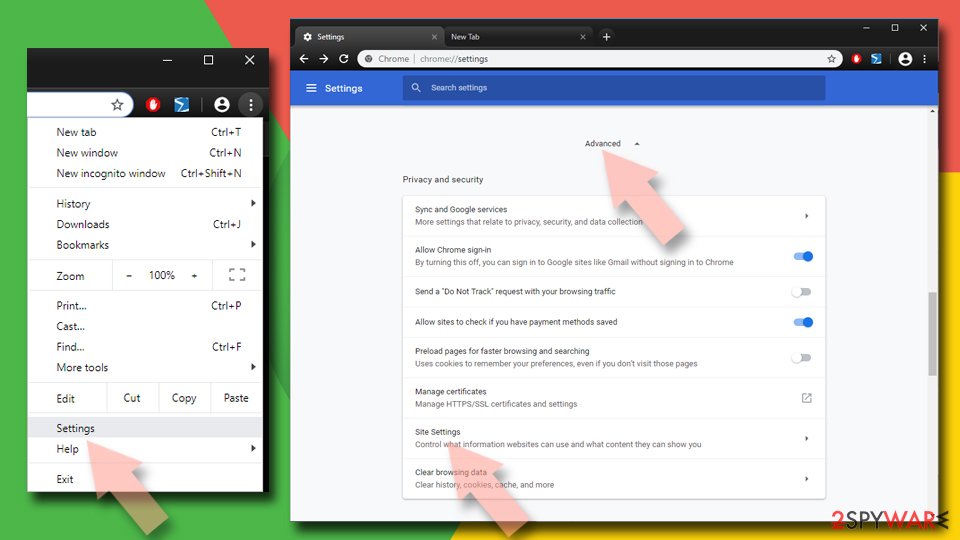
- Look at the Allow section and look for a suspicious URL.
- Click the three vertical dots next to it and pick Block. This should remove unwanted notifications from Google Chrome.
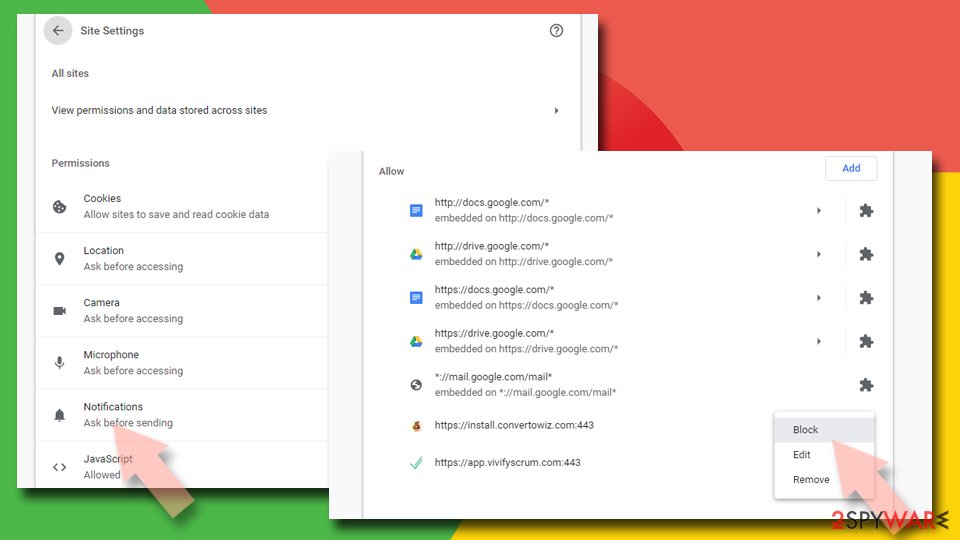
Remove unwanted notifications from Google Chrome (Android):
- Open Google Chrome and tap on Settings (three vertical dots).
- Select Notifications.
- Scroll down to the Sites section.
- Locate the unwanted URL and toggle the button to the left (Off setting).
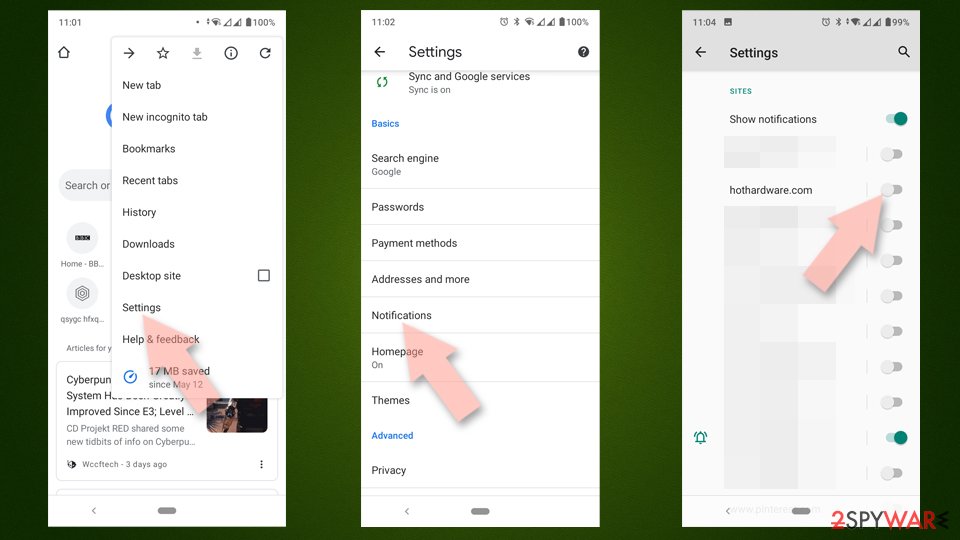
Remove unwanted notifications from Mozilla Firefox:
- Open Mozilla Firefox and go to Menu > Options.
- Click on Privacy & Security section.
- Under Permissions, you should be able to see Notifications. Click the Settings button next to it.
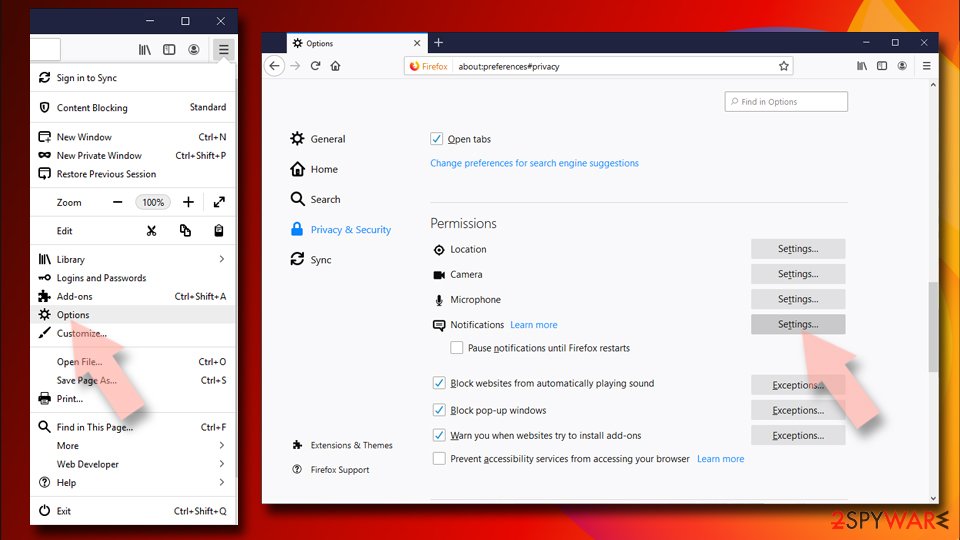
- In the Settings – Notification Permissions window, click on the drop-down menu by the URL in question.
- Select Block and then click on Save Changes. This should remove unwanted notifications from Mozilla Firefox.
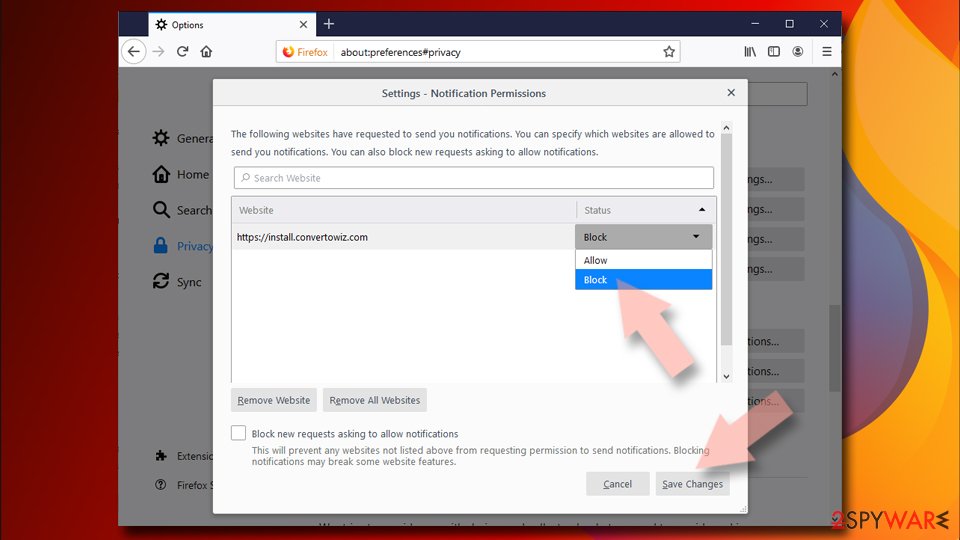
Remove unwanted notifications from Safari:
- Click on Safari > Preferences…
- Go to the Websites tab and, under General, select Notifications.
- Select the web address in question, click the drop-down menu and select Deny.
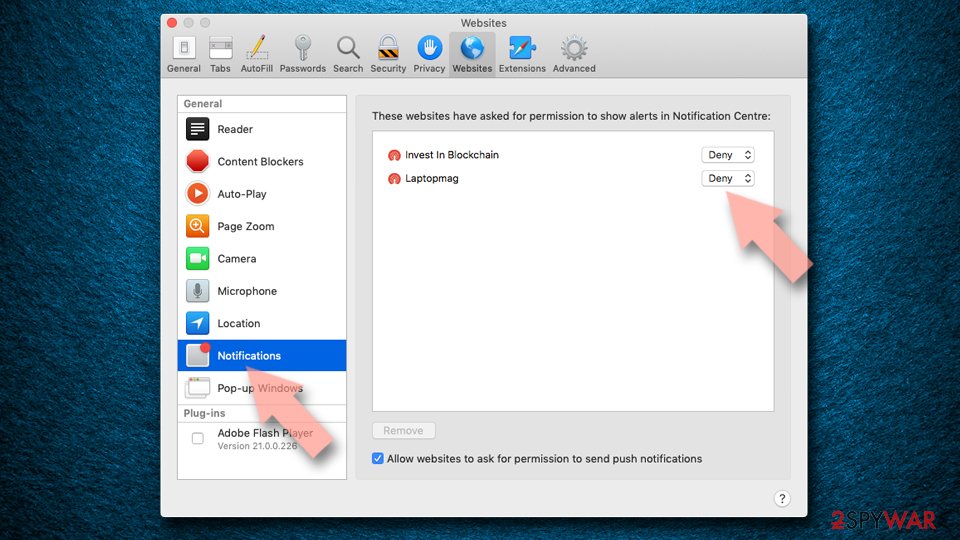
Remove unwanted notifications from MS Edge:
- Open Microsoft Edge, and click the Settings and more button (three horizontal dots) at the top-right of the window.
- Select Settings and then go to Advanced.
- Under Website permissions, pick Manage permissions and select the URL in question.
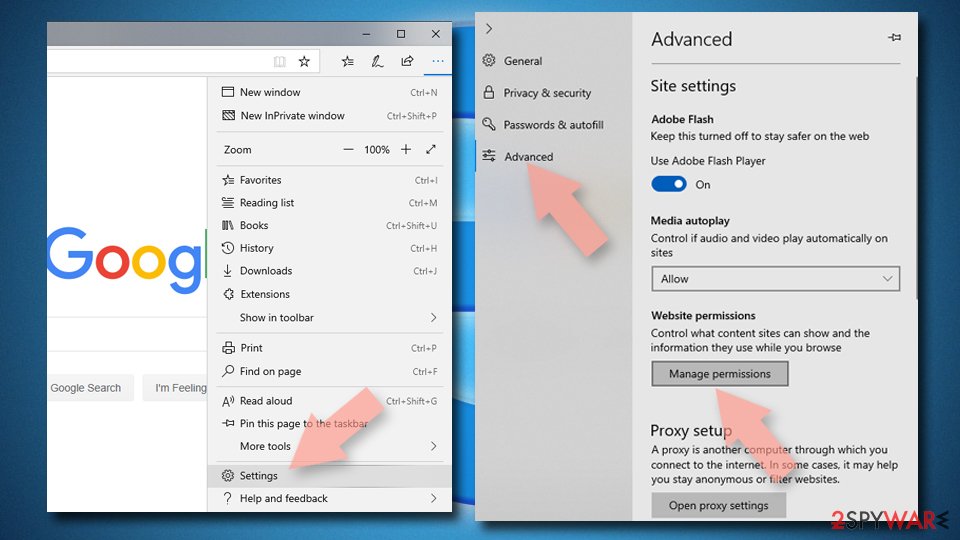
- Toggle the switch to the left to turn notifications off on Microsoft Edge.
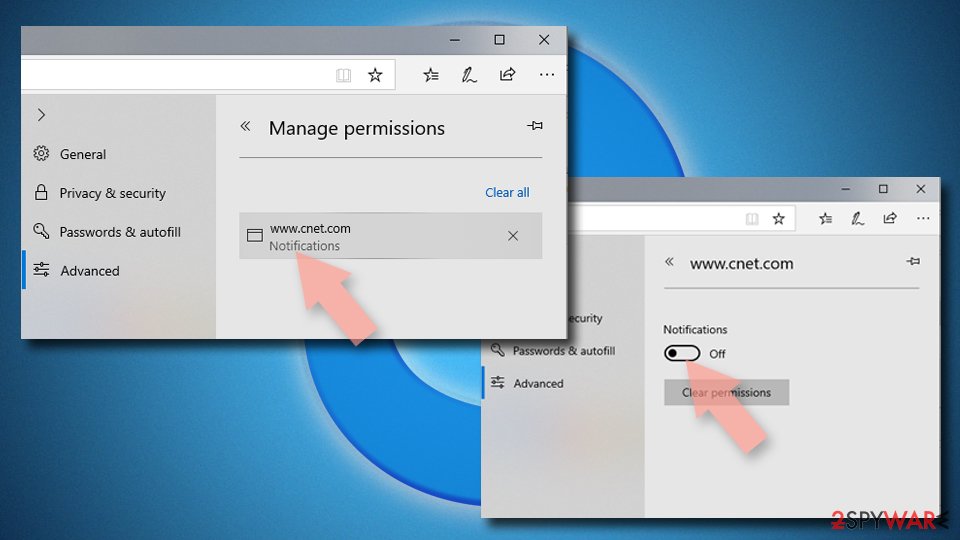
Remove unwanted notifications from MS Edge (Chromium):
- Open Microsoft Edge, and go to Settings.
- Select Site permissions.
- Go to Notifications on the right.
- Under Allow, you will find the unwanted entry.
- Click on More actions and select Block.
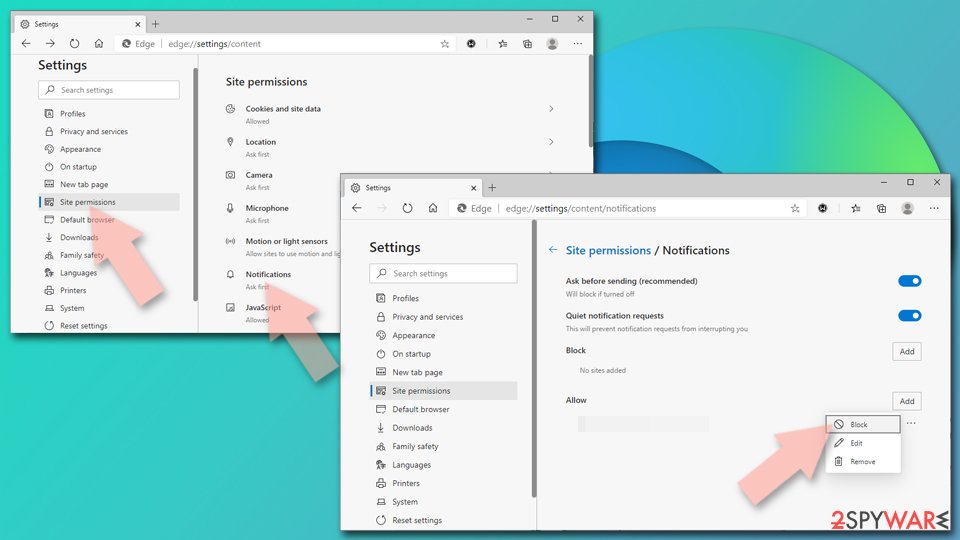
Remove unwanted notifications from Internet Explorer:
- Open Internet Explorer, and click on the Gear icon at the top-right of the window.
- Select Internet options and go to the Privacy tab.
- In the Pop-up Blocker section, click on Settings.
- Locate web address in question under Allowed sites and pick Remove.
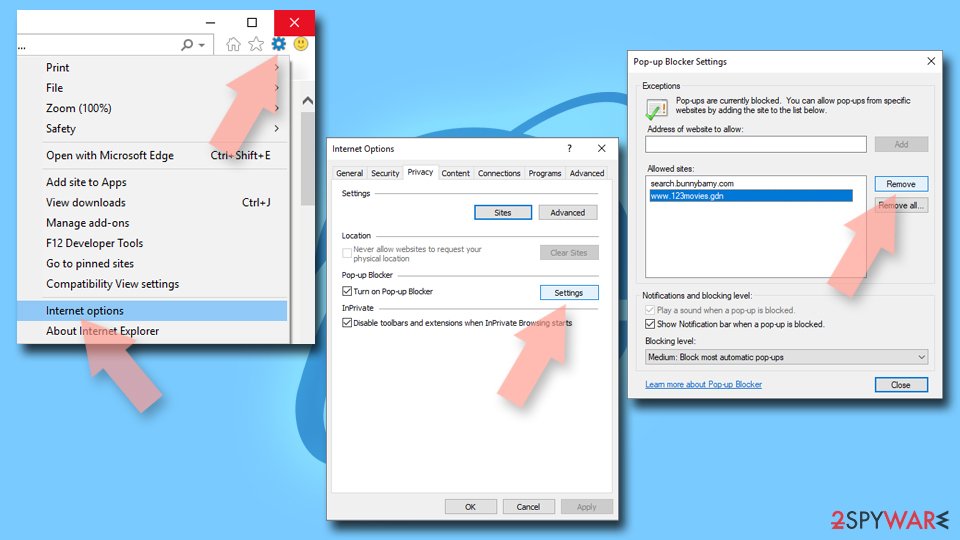
Remove from Microsoft Edge
Delete unwanted extensions from MS Edge:
- Select Menu (three horizontal dots at the top-right of the browser window) and pick Extensions.
- From the list, pick the extension and click on the Gear icon.
- Click on Uninstall at the bottom.

Clear cookies and other browser data:
- Click on the Menu (three horizontal dots at the top-right of the browser window) and select Privacy & security.
- Under Clear browsing data, pick Choose what to clear.
- Select everything (apart from passwords, although you might want to include Media licenses as well, if applicable) and click on Clear.

Restore new tab and homepage settings:
- Click the menu icon and choose Settings.
- Then find On startup section.
- Click Disable if you found any suspicious domain.
Reset MS Edge if the above steps did not work:
- Press on Ctrl + Shift + Esc to open Task Manager.
- Click on More details arrow at the bottom of the window.
- Select Details tab.
- Now scroll down and locate every entry with Microsoft Edge name in it. Right-click on each of them and select End Task to stop MS Edge from running.

If this solution failed to help you, you need to use an advanced Edge reset method. Note that you need to backup your data before proceeding.
- Find the following folder on your computer: C:\\Users\\%username%\\AppData\\Local\\Packages\\Microsoft.MicrosoftEdge_8wekyb3d8bbwe.
- Press Ctrl + A on your keyboard to select all folders.
- Right-click on them and pick Delete

- Now right-click on the Start button and pick Windows PowerShell (Admin).
- When the new window opens, copy and paste the following command, and then press Enter:
Get-AppXPackage -AllUsers -Name Microsoft.MicrosoftEdge | Foreach {Add-AppxPackage -DisableDevelopmentMode -Register “$($_.InstallLocation)\\AppXManifest.xml” -Verbose

Instructions for Chromium-based Edge
Delete extensions from MS Edge (Chromium):
- Open Edge and click select Settings > Extensions.
- Delete unwanted extensions by clicking Remove.

Clear cache and site data:
- Click on Menu and go to Settings.
- Select Privacy, search and services.
- Under Clear browsing data, pick Choose what to clear.
- Under Time range, pick All time.
- Select Clear now.

Reset Chromium-based MS Edge:
- Click on Menu and select Settings.
- On the left side, pick Reset settings.
- Select Restore settings to their default values.
- Confirm with Reset.

Remove from Mozilla Firefox (FF)
Remove dangerous extensions:
- Open Mozilla Firefox browser and click on the Menu (three horizontal lines at the top-right of the window).
- Select Add-ons.
- In here, select unwanted plugin and click Remove.

Reset the homepage:
- Click three horizontal lines at the top right corner to open the menu.
- Choose Options.
- Under Home options, enter your preferred site that will open every time you newly open the Mozilla Firefox.
Clear cookies and site data:
- Click Menu and pick Settings.
- Go to Privacy & Security section.
- Scroll down to locate Cookies and Site Data.
- Click on Clear Data…
- Select Cookies and Site Data, as well as Cached Web Content and press Clear.

Reset Mozilla Firefox
If clearing the browser as explained above did not help, reset Mozilla Firefox:
- Open Mozilla Firefox browser and click the Menu.
- Go to Help and then choose Troubleshooting Information.

- Under Give Firefox a tune up section, click on Refresh Firefox…
- Once the pop-up shows up, confirm the action by pressing on Refresh Firefox.

Remove from Google Chrome
Delete malicious extensions from Google Chrome:
- Open Google Chrome, click on the Menu (three vertical dots at the top-right corner) and select More tools > Extensions.
- In the newly opened window, you will see all the installed extensions. Uninstall all the suspicious plugins that might be related to the unwanted program by clicking Remove.

Clear cache and web data from Chrome:
- Click on Menu and pick Settings.
- Under Privacy and security, select Clear browsing data.
- Select Browsing history, Cookies and other site data, as well as Cached images and files.
- Click Clear data.

Change your homepage:
- Click menu and choose Settings.
- Look for a suspicious site in the On startup section.
- Click on Open a specific or set of pages and click on three dots to find the Remove option.
Reset Google Chrome:
If the previous methods did not help you, reset Google Chrome to eliminate all the unwanted components:
- Click on Menu and select Settings.
- In the Settings, scroll down and click Advanced.
- Scroll down and locate Reset and clean up section.
- Now click Restore settings to their original defaults.
- Confirm with Reset settings.

Delete from Safari
Remove unwanted extensions from Safari:
- Click Safari > Preferences…
- In the new window, pick Extensions.
- Select the unwanted extension and select Uninstall.

Clear cookies and other website data from Safari:
- Click Safari > Clear History…
- From the drop-down menu under Clear, pick all history.
- Confirm with Clear History.

Reset Safari if the above-mentioned steps did not help you:
- Click Safari > Preferences…
- Go to Advanced tab.
- Tick the Show Develop menu in menu bar.
- From the menu bar, click Develop, and then select Empty Caches.

How to prevent from getting adware
Do not let government spy on you
The government has many issues in regards to tracking users' data and spying on citizens, so you should take this into consideration and learn more about shady information gathering practices. Avoid any unwanted government tracking or spying by going totally anonymous on the internet.
You can choose a different location when you go online and access any material you want without particular content restrictions. You can easily enjoy internet connection without any risks of being hacked by using Private Internet Access VPN.
Control the information that can be accessed by government any other unwanted party and surf online without being spied on. Even if you are not involved in illegal activities or trust your selection of services, platforms, be suspicious for your own security and take precautionary measures by using the VPN service.
Backup files for the later use, in case of the malware attack
Computer users can suffer from data losses due to cyber infections or their own faulty doings. Ransomware can encrypt and hold files hostage, while unforeseen power cuts might cause a loss of important documents. If you have proper up-to-date backups, you can easily recover after such an incident and get back to work. It is also equally important to update backups on a regular basis so that the newest information remains intact – you can set this process to be performed automatically.
When you have the previous version of every important document or project you can avoid frustration and breakdowns. It comes in handy when malware strikes out of nowhere. Use Data Recovery Pro for the data restoration process.
